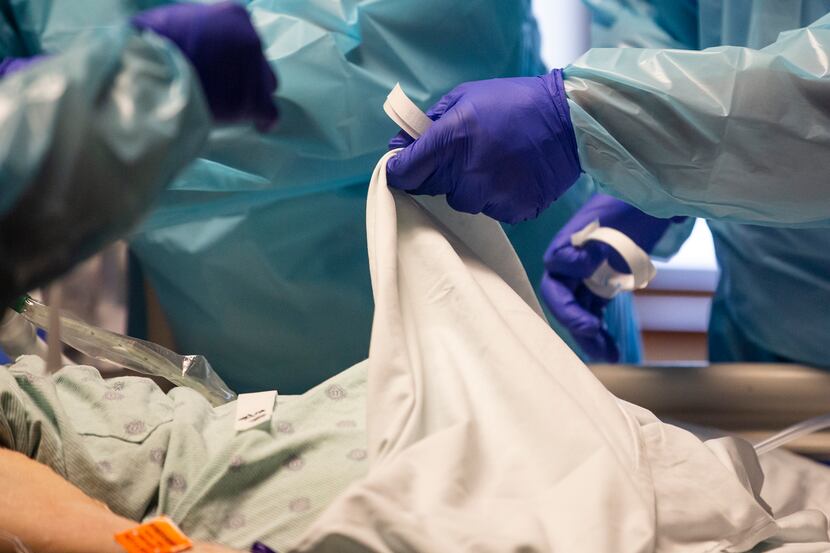AUSTIN — Over 1 million Texans have now tested positive for COVID-19, and with holidays approaching, experts warn that the current surge of cases will swell even further.
Dallas County hit a high for new cases in a single day this week, logging more than 1,400 positive test results on Tuesday. Hospitals in El Paso are filling with coronavirus patients, and the morgue has reached capacity. Case counts statewide have rebounded to July Fourth levels that at the time were alarming enough for Gov. Greg Abbott to impose a mask mandate, which remains in effect. University of Texas at Austin scientists project that the disease could claim 1,000 more Texans by the end of the month.
In North Texas, too, the forecast for the coming weeks is dire. UT Southwestern scientists are predicting that hospitalizations and daily case counts in Dallas County will set records in the days leading up to Thanksgiving.
“This upward trend is more concerning than the summer upward trend,” said Erin Carlson, director of graduate public health programs at the University of Texas at Arlington.
New social distancing policies are unlikely, community spread is high, and people have quarantine fatigue — a perfect storm, Carlson said, that “portends a surge in cases that’s unlike anything we have seen to date.”
Government officials across the country are grappling with how to contain the virus, a task made more difficult by the absence of a coordinated national strategy. This week, some states tightened their restrictions as caseloads climbed.
By the end of the week, Texas and California will each have logged over 1 million confirmed COVID-19 cases since the pandemic began. While other counts already show both states surpassing that number, the official state tally for Texas broke 1 million on Friday. California was just shy of that mark.
The true number of Texans with the virus is higher, however, because not all show symptoms and not all who are considered sick are included in the tally. Per capita, states including North and South Dakota have been hit harder.
Abbott signaled he wouldn’t impose new rules and instead urged people to follow existing public health guidelines. Local officials in some of the hardest hit areas of the state, however, are clamoring for the legal authority to issue new orders meant to slow the spread.
With Thanksgiving and flu season around the corner, public health experts are warning against gathering in large groups and traveling to visit family. But they worry that a nation already fatigued from months of restrictions won’t heed that advice.
“If we are able to do each our own part individually, we are not going to have to resort to more communitywide measures,” said Dr. John Carlo, CEO of Prism Health North Texas and a member of the Texas Medical Association’s COVID-19 Taskforce. “But when these types of individual measures are failing, then there’s really no choice.”
Already, the pandemic has killed more than 19,000 people in Texas, most of them over age 70.
While hospitals in the Dallas-Fort Worth area say they have enough beds and personal protective gear, executives are competing for staff with other parts of the state that are experiencing surges.
“You can have all the beds you want, but if you can’t staff them, what good are they?” said Steve Love, president and CEO of the Dallas-Fort Worth Hospital Council.
Holiday dangers
In Texas, the number of people hospitalized with COVID-19 began marching steadily higher in early October.
Scientists at UT Southwestern say Thanksgiving could prove the most problematic holiday of the epidemic yet. A forecast they released Thursday predicts that by the end of November Dallas County will see 2,500 new cases a day, and that nearly 900 COVID-19 patients will be in hospitals. Case counts are not just climbing; the climb is accelerating, making the disease even harder to control.
“This is the tragedy of letting it get out of hand,” Dr. Michael Mina, an epidemiologist at the Harvard T. H. Chan School of Public Health, said at a news briefing last week. “Our options dwindle and dwindle and dwindle every day.”
Disease experts are pleading for officials to act.
“In the face of national emergency during which hospitals are being overrun across the country, we urgently need a public response from our leaders,” researchers from the Children’s Hospital of Philadelphia wrote this week. The group suggests quarantine periods before and after Thanksgiving, the December holiday season and New Year’s. Gatherings need to be small, employers must let people work from home, and bars and restaurants should shorten hours, cut occupancy, or both.
In some states, officials have made those changes. This week, New York and Massachusetts ordered bars and restaurants to close early, and limited indoor gatherings to 10 people. Some parts of California have again banned indoor dining.
In radio and TV interviews, Abbott strongly suggested this week that he wouldn’t change his guidelines, and he ruled out lockdowns.
Abbott said the state can “surge” medical personnel, supplies and tests to hot spots, and he emphasized voluntary compliance with public health guidelines, such as handwashing and wearing a mask.
“Candidly, people have let down their guard,” Abbott told KETK-TV in Tyler on Thursday. “A lot of the spread is occurring in private settings, with friends and family members gathering together.”
Under Abbott’s orders, many businesses in Texas, such as restaurants, bowling alleys and movie theaters, are open at 75% of capacity. Regions where more than 15% of hospital beds are taken up by coronavirus patients must scale back. The area that includes Dallas County is nearing that threshold; three areas have surpassed it: El Paso, Lubbock and Amarillo.
El Paso County Judge Ricardo Samaniego has sought to shut down nonessential businesses, but Texas Attorney General Ken Paxton and a group of local restaurants challenged his order and it remains tied up in court.
Dallas County Judge Clay Jenkins said he has done all he can do in terms of official orders to curb the spread of the disease.
The county’s public health committee asked Abbott’s office this week to adjust his executive orders here, including by eliminating the provision that lets bars open by selling food, allowing the county to prohibit in-person dining at restaurants, prohibiting in-person fitness classes at gyms and limiting indoor gatherings to 10 people or fewer.
“They’re not saying we need to go to full lockdown mode,” Jenkins said. “They’re saying if we do these few things, as a community of people sacrifice these few things, we can get to where we need to be and we don’t get to a place where we’ve got mobile morgues.”
What’s ahead
New antibody therapies like the one used to treat President Donald Trump, as well as vaccines, should be distributed to Texas over the coming months, Abbott said. But in the short term, new medications will have only a small impact, experts say.
“I wouldn’t make any plans that don’t involve masks and distancing through the end of 2021,” said UTA’s Carlson. Even if promising early results from vaccine trials pan out, it will take months for the medications to reach most Americans.
Health care workers, first responders, the elderly and other high-risk populations will probably be first to receive a vaccine, once one is approved.
Meanwhile, hospitals in North Texas are preparing for a wave of new patients.
At Parkland Memorial Hospital, there are about 100 people patients with the virus, a number that has tripled in the last month, said Dr. Joe Chang, chief medical officer for Parkland Health and Hospital System.
The hospital has set up four wards exclusively for COVID-19 that can hold between 190 and 200 patients. It is prepared to open up three more and has made “contingency plan on top of contingency plan” in preparation for the worst-case scenario, Chang said.
The largest concern is staffing, as nurses and doctors are logging extra hours and patients could be doubled up in rooms, Chang said.
“The number of docs and nurses that, on their break, are going to the break room and just crying, it’s a staggering number now,” he said. “These individuals work themselves to exhaustion, and sometimes all you can do is cry and then put your PPE on and do it again. If the public could know one thing, and they could have one motivating factor, it’s to please help my troops, help my docs and nurses by not getting sick. That’s really what I need.”
Then, there’s a large group of people who have survived COVID-19 but need continuing care.
UT Southwestern’s COVID Recover Program began operating in early June to help what have become known as coronavirus “long haulers,” people who experience symptoms weeks or months after they first contracted the virus. The most common are physical and mental; the most serious can include lung problems, cardiac issues, neurological problems and blood clotting, said Dr. Surendra Barshikar, medical director of UT Southwestern’s rehabilitation clinics, who oversees the COVID Recover Program.
About 30 people are currently being treated through the clinic, both patients who were previously hospitalized at UTSW and patients who were never hospitalized or were treated at other facilities.
Barshikar said even with hopes of a COVID-19 vaccine, people will continue to need treatment provided through the program for long periods.
“We are seeing more and more of these chronic symptoms,” he said. “Even if the acute phase or the surge passes, we will continue to see the aftereffects for a while.”
Austin Bureau chief Robert T. Garrett and staff writers Holly K. Hacker and Anna Kuchment contributed to this report.



